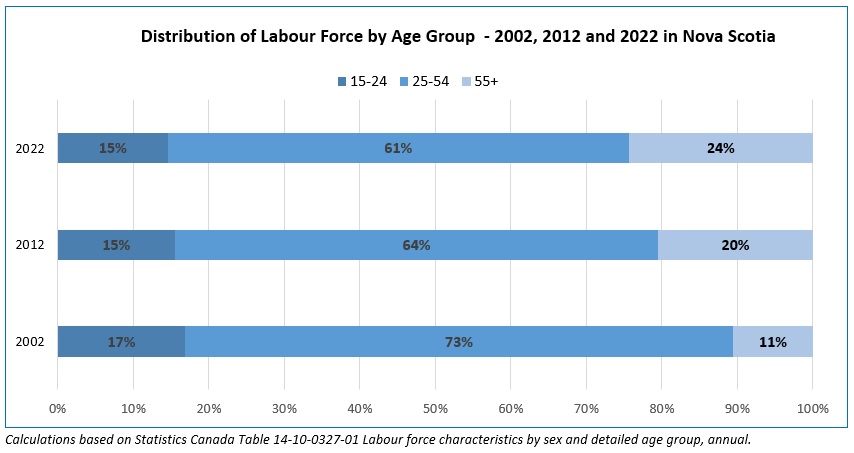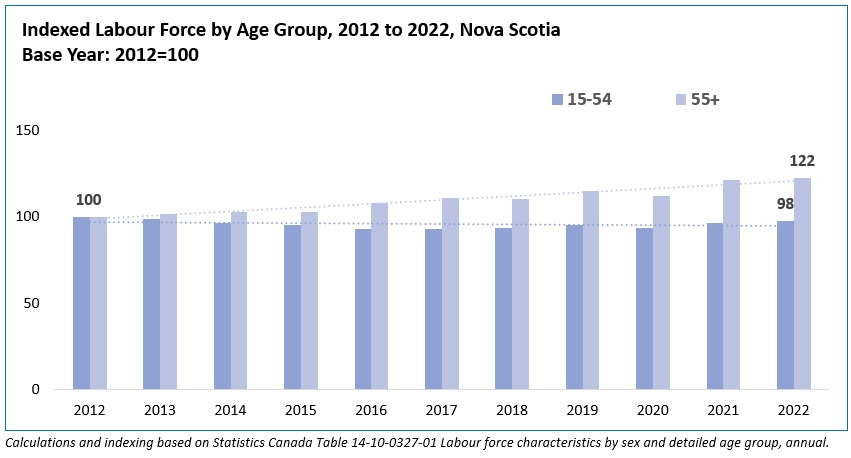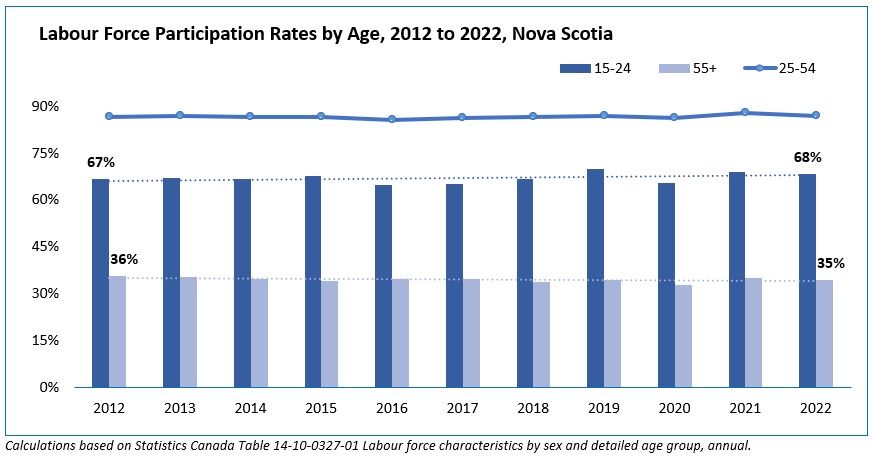Age Distribution in the Workforce
Nova Scotia's labour statistics continue to reflect the demographic shift attributed to the ageing baby boomer population (people born between 1946 and 1964). In the last decade, the number of people in Nova Scotia’s workforce has, on average, been stable because of an increase in the proportion of older workers (those age 55 years and older) in the workforce.
In contrast, the proportion of youth and core-aged workers has declined. The share of older workers in the workforce has been greater than the proportion of youth (15 to 24 years) in 2012 as well as in 2022.

From 2002 to 2012, the share of older workers in the labour force rose from one-tenth (11%) to one-fifth (20%), and for the period of 2002 to 2022, it rose from one-tenth (10%) to almost a quarter (24%).
- The growth in the workforce aged 55 and up was concentrated in the years 2002 to 2012 which coincides with the baby boomer population entering the older worker demographic. In 2022, older workers (55+) accounted for 24% of the total workforce, near the highest proportion for this age group on record, with only 2021 slightly higher (data available from 1976 to 2022).
- The population aged 55 and over also accounted for an increasing share of the population not in the labour force (from 61% in 2002 to 68% in 2012 and to 74% in 2022).
- Youth (ages 15-24) accounted for 15% of the labour force in both 2002 and 2012, and this proportion rose to 17% in 2022.
- The prime working age group (25-54) accounted for 61% of the labour force in 2002, 64% in 2012 and 73% in 2022. The share of the prime working age group has steadily declined since it peaked at 75% in 1997.

Participation Rate
The labour force participation rate gives an indication of the willingness of those of working age to participate in the labour market. In addition to economic conditions, some factors that can affect participation rates include:
- the age distribution of the population
- the industrial makeup of the province
- the percentage of the population engaged in educational activities.
While higher rates of educational enrollment have contributed to lower participation rates for youth (ages 15 to 24 years), declining fertility boosted youth participation which increased by 3.1 percentage points from 2017 to 2022.
Due to COVID-19’s disproportionate effect on the youth labour market, the youth participation rate dropped 4.4 percentage points, from 69.8% in 2019 to 65.4% in 2020. The youth participation rate rebounded in 2021, however, increasing by 3.7 percentage points to 69.1%. It then decreased in 2022 by 0.7 percentage points to 68.4%.
In the past, youth have had lower participation rates than those aged 25 to 54 (core working age), but higher than those aged 55 years and over. The gap between participation rates for youth and older adults (ages 55+) has grown slightly over the last 10 years due to the changing demographics in Nova Scotia, however, it has been mitigated by delayed retirements.
Participation rates over the last ten years have risen slightly among youth, core-aged workers, and older workers (shown in the graph below). This is despite an expectation that participation drops with advanced age. Additionally, retirees are considered non-participants, which contributes to lower participation rates among higher age groups.

- In 2022 the participation rate in Nova Scotia was lower than that of the national average, while simultaneously being the third lowest in Atlantic Canada and among 10 provinces.
- Nova Scotia’s participation rate decreased by 0.7 percentage points from 2021 to 2022

Aside from the recent effects of COVID-19, the labour force participation rate in Nova Scotia has declined in most years since 2012, falling by 3.0 percentage points in the ten-year span to 2022. The lower participation rate reflects several factors, including an older population who tends to have lower levels of labour force participation.
